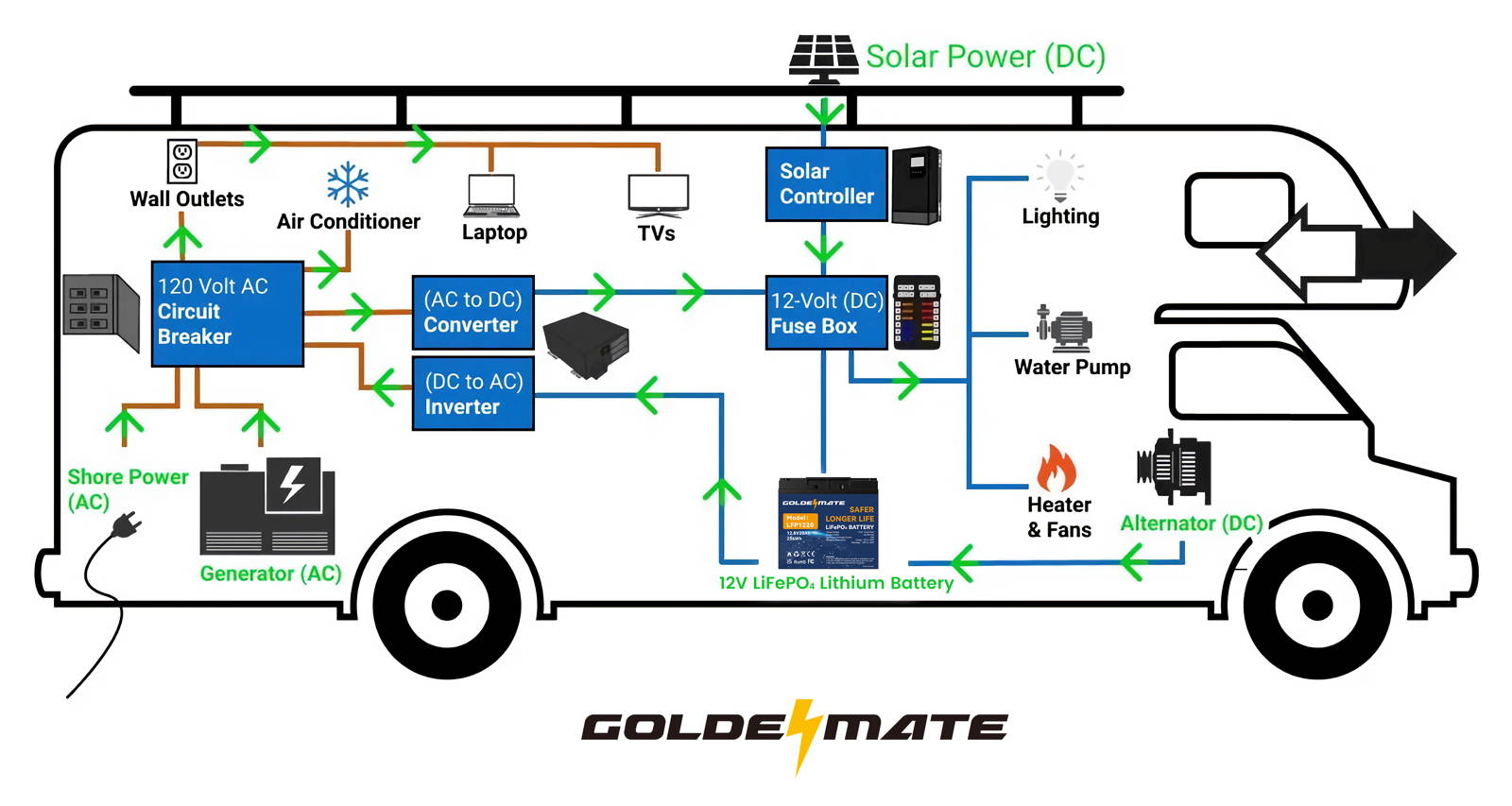RV VAN CAMPER

4 WAYS TO POWER YOUR LITHIUM RV
RVs, campers, and vans have two types of batteries. One is the starter battery or main battery, which is used to start the RV. Keep in mind that main batteries do bot supply power to your RV’s household appliances.
For that purpose, a second battery is utilized to power your appliances such as air conditioner, hairdryer, microwave, electric heater, fridge etc. This is the lithium deep cycle battery, also called a RV house battery, motorhome battery, lithium leisure battery, the living battery or secondary battery. Goldenmate lithium batteries are the deep cycle battery.
There are four ways to power RVs: Mains Charging, Drive Charging/Vehicle Alternator, Solar Charging, and Fuel Generator Charging.
1. Main Charging
Your RV lithium batteries can be charged through external 110V/220V city power through a converter charger. You can also use RV shore power for your AC appliances while it charges your batteries as well.
2. Drive Charging / Vehicle Alternator
You can also charge your lithium batteries while driving by using the alternator on your RV. The alternator in a motorhome should automatically charge both the house and vehicle batteries. However, this method is time-consuming and tedious.
A DC to DC battery charger can significantly accelerate the charging process. This raises the charging amps from 5 to 20 amps, allowing your alternator to charge your house batteries more quickly.
3. Solar Charge
Solar panels are beneficial for long term use. You can set up solar panels to generate electricity and charge your batteries through an inverter and solar charge controller.
4. Fuel Generator Charging
When you have no AC source available and the sun isn’t there to charge your batteries either, time to take out your generator. Generators are a life-saving source of electricity when none other is available and only require fuel, gasoline or propane. They can power your AC appliances and can quickly charge your batteries.
Additionally, you can also use both solar and drive charging to charge the Battery faster.
WHAT COMPONENTS DO YOU NEED FOR YOUR RV ELECTRICAL SYSTEM?
Lithium Battery
Lithium RV batteries are designed for longevity. Even after 4000 cycles, they’re still capable of producing 70% of the rated capacity. Goldenmate lithium iron phosphate (LiFePO₄) batteries last up to 10 years, making the price per watt a fraction of traditional batteries.
Battery Monitor
Battery monitors are excellent tools that can tell you your Battery’s data like SOC, battery voltage and current, capacity etc. However, you need an external battery monitor if you choose Goldenmate Lithium (LiFePO₄) batteries.
Inverter Charger
An inverter charger combines an inverter and a battery charger. You can use a generator or shore power to charge your DC battery bank, and it will also convert DC battery power to AC power for household appliances and devices.
Converter Chargers
A converter converts AC to DC. Most RV electrical components function on DC power, while most domestic appliances need AC power. You’d need a converter charger to charge your battery bank from AC power, and it also allows you to distribute DC power to your onboard electrical components. Make sure to choose the right type of charger for your batteries to get maximum performance.
Battery Guardian
If you need a low voltage disconnect, the battery guardian (BG) is an excellent component. When storing your system over an extended period, utilizing a BG is a great option.
When you include a BG into your system, it acts as a direct current (DC) disconnect switch, cutting offloads when your batteries exceed 11.5 V. This protects your batteries during long-term storage by preventing loads from draining them and eliminates the time-consuming chore of physically detaching the battery line from the bank of batteries.
Solar Panels
Installing a solar system is smart but perplexing at the same time. Should you use monocrystalline, polycrystalline, or a thin film? Do you require 12-volt panels, 24-volt panels, 48-volt panels, or even 72-volt panels?
Hopefully, after you finish this section, you will be able to make a smarter decision for your RV.
How many watts?
For each 100 Ah of lithium battery capacity, aim for a solar array of 200-250 watts. In one full day of direct sunlight, you’d be able to charge your phone from empty to fully charged. To charge your lithium batteries, you’ll need a solar charge controller that’s compatible with that system.
Should I connect my array in series or parallel?
Your solar charge controller will determine this. PWM controllers benefit from parallel connections. Parallel solar connections also allow for shadow tolerance, which means that even if one panel in the array is shaded, the remaining panels continue to produce power.
Series connections are preferable with MPPT controllers because the increased voltage generated by connecting in this manner can result in greater efficiency. However, unlike parallel connections they tend to lose power if one of the panels is shaded. People usually combine series and parallel to have the best of both worlds.
Solar Charge Controller
The amount of power going from your solar array to your battery bank is controlled by a solar charge controller, which is a current or voltage controller.
Solar charge controllers are classified into two types:
Pulse Width Modulation (PWM)
Pulse width modulation solar charge controllers are straightforward controllers that connect your solar array to your battery bank. PWM solar controllers often only handle 12 or 24 volts.
Maximum Power Point Tracking (MPPT)
Maximum Power Point Tracking solar charge controllers are a more complicated but gather more energy from the solar array, resulting in better efficiencies. They can handle a variety of voltages, allowing you to construct a solar array with practically any voltage type.
DC to DC Charger
The alternator and starting battery in your car can be used in conjunction with DC to DC or Battery to battery chargers to recharge your Batteries. When not in use, these chargers isolate the chassis and coach batteries for quick and efficient charging.














